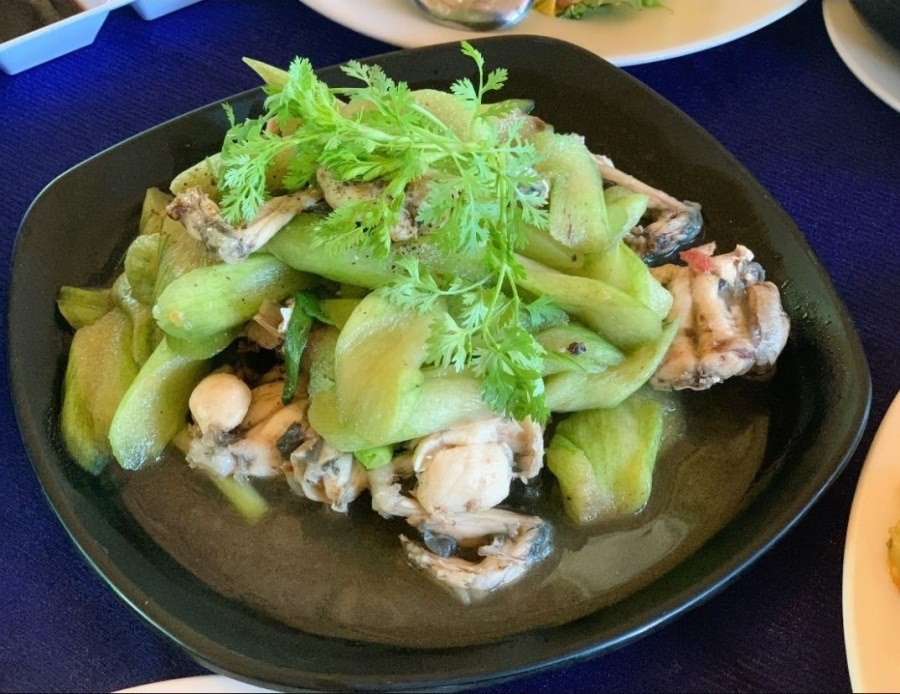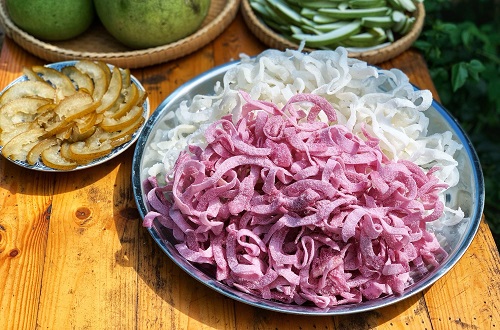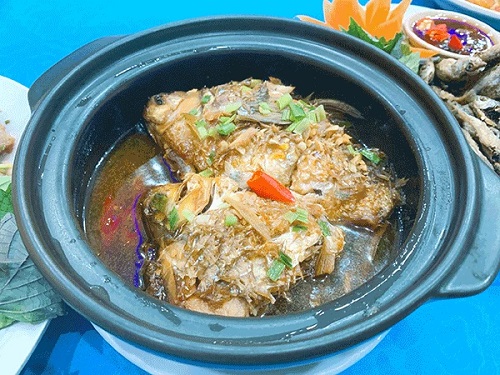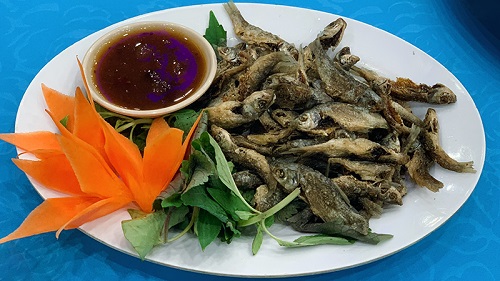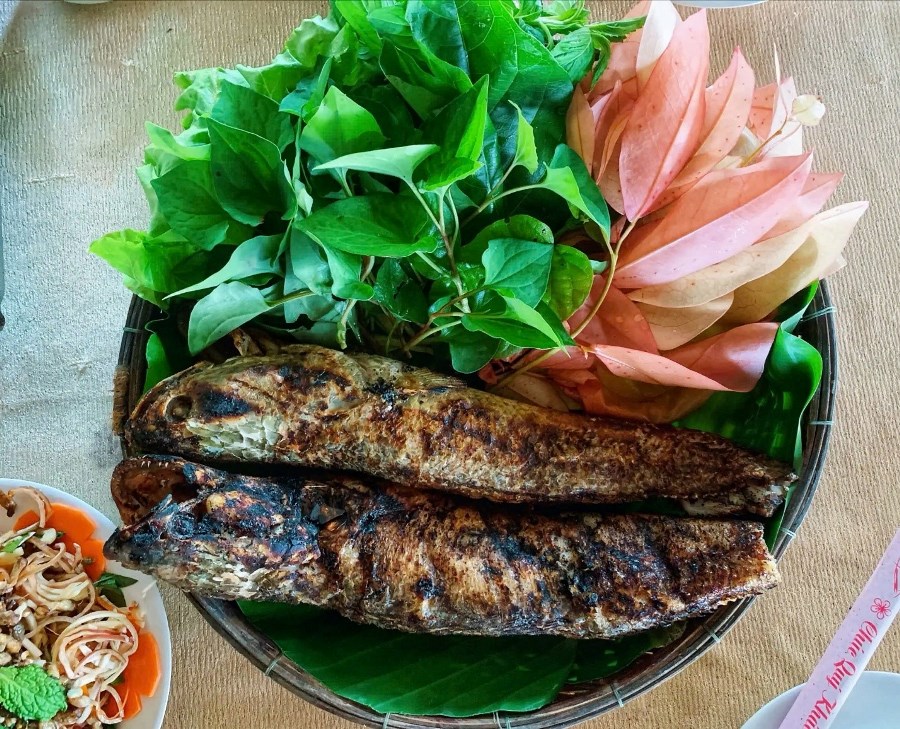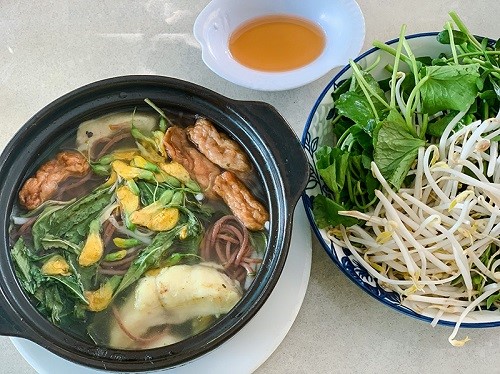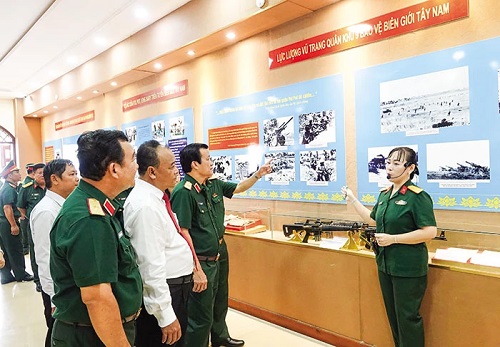
The exhibition is organized into 5 sections. The first includes images, documents, and artifacts about the combat solidarity between Vietnam and Cambodia during the National Liberation War. The second part is about the crimes of Pol Pot - Ieng Sari along the Southwest border of Vietnam. The third part is about the Armed Forces of Military Zone 9 defending the Southwest border. The fourth part is about fulfilling international duties together with the Cambodian people in defeating the genocidal regime. And finally, it's about the solidarity and friendship between Vietnam and Cambodia in the new era.
Nearly 300 photos, documents, and artifacts help viewers understand more about the border defense war of the Motherland, the long-standing traditional friendship and solidarity between the Parties, States, and peoples of the two countries, and reinforce the firm trust in the foreign policy of the Party and the task of firmly defending the Socialist Republic of Vietnam.
Immediately after seizing power in April 1975, the Pol Pot - Ieng Sari group took advantage of the revolutionary achievements, betrayed the Cambodian people, and established what was called the "Cambodian Democratic State", implementing a genocidal regime, purging internally, killing millions of innocent people, destroying hundreds of thousands of schools, hospitals, pagodas...
In just 2 years (from April 30, 1975, to April 30, 1977), Pol Pot reorganized administrative units, organized the machinery of power in villages, communes, districts, and provinces in a military manner, purging opponents; they built forces, developed the main force army from 7 divisions at the time of liberation to 12 regular army divisions with full branches, tens of thousands of local troops. Pol Pot declared: "Even if we have to kill another million, we will resolutely do so, killing an innocent by mistake is better than sparing an opponent; in the family, if one person goes to the forest to be an opponent, three generations will be killed”.
Towards Vietnam, the Pol Pot - Ieng Sari group distorted history, incited hatred, and instigated ethnic animosity. Just in 2 years (1975-1977), they mobilized 41% of troops and equipment along Vietnam's border; committing bloody crimes against our people. They seriously violated Vietnam's independence, sovereignty, and territorial integrity, trampling on the noble values in the friendly relations between the two countries and peoples.
On May 3, 1975, they seized Phu Quoc Island; on May 10, 1975, they seized Tho Chu Island, capturing and killing over 500 civilians. On land, they provoked our border guards, forcing people to relocate boundary markers in some areas of Tay Ninh, Kon Tum, and Dak Lak provinces. In October 1975, they infiltrated the Pa Cham (Lo Co) area, encroaching on the Moc Bai, Khuoc, Vat Sa, Ta Not, Ta Bat areas. Late 1975, early 1976, Pol Pot troops suddenly launched some surprise attacks, penetrating deep into Vietnamese territory in some places over 10km like in the Sa Thay River area (Gia Lai, Kon Tum).

The special exhibition "The Solidarity and Friendship between Vietnam and Cambodia" features many valuable images, artifacts, and documents. Photo: DUY KHOI.
In late February and early March 1976, Pol Pot provoked the border outposts No. 7 and No. 8 in Bu Prăng (Dak Lak). In late 1976, they increased encroachment and occupation activities along our border. In Military Zone 7's area, they caused 280 provocations, occupying 20 points along the border. In Military Zones 5 and 9's areas, infiltrations increasingly grew with a more serious nature.
In March and April 1977, Pol Pot forces repeatedly launched many exercises along our border under the guise of "defense of the area" and "ensuring domestic security", but their real purpose was troop mobilization. In late April 1977, Pol Pot mobilized 5 divisions, hundreds of artillery pieces, and tanks along Vietnam's border, carrying out a large-scale invasion plot into our Southwest border area.
To protect the sacred sovereignty of the Motherland, and protect the lives and property of the people, our Party and State on one hand directed military zones, localities, and units to strengthen preparedness and defensive posture, resolutely smash any invading attacks of the enemy; on the other hand, persistently pursued the policy of building a peaceful, friendly borderline, many times proposing negotiations with the Cambodian government.
Reading the list of crimes Pol Pot forces inflicted on the people of An Giang Province displayed at the exhibition is chilling at the numbers: 4,158 people along the entire Southwest border were massacred; 774 people were injured; 4,500 houses were destroyed; 36 communes, and wards and towns were ravaged, including the complete destruction of 8 communes... Just in Ba Chuc, over 3,000 people were slaughtered indiscriminately. Most schools, clinics, pagodas, and churches along with people's property were wantonly and brutally destroyed by Pol Pot. Or when viewing artifacts of Pol Pot's crimes against people in An Giang's border communes, viewers can't help but feel moved and terrified by the genocide.
At the exhibition, viewers were able to read excerpts from the "Combat Order of the Ministry of Defense", defining: "...We must recapture all the islands and lands that Pol Pot had seized..." There were also images of enthusiastic youth signing up to defend the homeland, images of Regiment 2, Division 330 annihilating Pol Pot's troops in Vinh Dieu Village, Ha Tien, Kien Giang on July 13, 1977, or scenes of Artillery Regiment 6, Military Region 9 providing fire support for infantry advancing to attack Pol Pot's troops defending the Southwestern border in 1978...
In response to the call of the Cambodian revolution, Vietnam provided assistance to help the Cambodian people overthrow the genocidal Pol Pot regime, saving the Cambodian nation from destruction - this was a legally and morally appropriate action, demonstrating a high-minded, pure, righteous and affectionate international spirit, willing to sacrifice bones and blood for the traditional, long-standing relationship between the Parties, states and peoples of the two countries. This continued the tradition of jointly fighting and defeating the common enemy of the two peoples. Cambodian Prime Minister Hun Sen affirmed: "Without January 7, 1979, we the Cambodian people would not have what we have today. This is an irrefutable historical truth that no reactionary force can deny”.
For 10 years (1979-1989), Vietnam simultaneously carried out 3 tasks in Cambodia. Vietnam helped the Cambodian revolutionary armed forces build strength while coordinating combat operations to sweep out remnants of Pol Pot's forces in border areas to the west, northwest, and inland regions. Vietnam helped build and consolidate the revolutionary government system and mass organizations from the central to local levels and organized the training and nurturing of cadres at all levels. Vietnam sent thousands of cadres, experts, and Vietnamese volunteer soldiers to remain and continue assisting the revolution and the people of Cambodia in stabilizing and recovering in all fields: economy, culture, education, transport, health, … caring for the people's livelihoods.
During the 10 years serving the noble international mission in Cambodia, cadres and soldiers of the Volunteer Army and Vietnamese experts demonstrated a staunch will, devoted heart and soul to the revolutionary cause of the Cambodian people, overcoming harsh trials to excellently fulfill all tasks. Tens of thousands of cadres, soldiers of the Volunteer Army, and Vietnamese experts bravely sacrificed in the friendly land for their noble international duty. The Cambodian people affectionately called the Vietnamese volunteer soldiers "Buddhist soldiers." When the situation in Cambodia became stable, on September 26, 1989, before the eyes of the international press, the last units of the Vietnamese Volunteer Army withdrew troops back home amidst the longing of the local people in the Land of Pagodas.

The Cambodian people bade farewell to the Vietnamese Volunteer Army completing its international mission and returning to the Homeland, in September 1989. Archive photo of Military Region 9 Museum.
On the day the Vietnamese Volunteer Army returned home, the Pracheachon newspaper of Cambodia had an editorial saying: "During the extremely tragic years under the Pol Pot genocidal regime, in this world, there were countless powerful, wealthy countries but only our poor neighboring country Vietnam came to save our nation". Prime Minister Hun Sen has affirmed: "Without Vietnam's assistance, Cambodia would not exist today, absolutely not”.
One feels deeply moved by the images at the exhibition, such as scenes of the Medical Corps of Division 330 treating the Cambodian people; scenes of the Vietnamese Volunteer Army distributing rice to save Cambodians from starvation in 1979, or scenes of the Vietnamese Volunteer Army bringing Cambodian people back to their homeland after the day of liberation in January 1979. Also moving are images of the Vietnamese Volunteer Army helping the people of Kampot province plant rice to stabilize their livelihoods.
Before the righteousness and affection of the Vietnamese Volunteer Army, the Cambodian people have shown beautiful feelings. Images of the people of Phnom Penh, Cambodia bidding farewell to the Vietnamese Volunteer Army completing its international mission and returning to the Homeland in 1989 is an example. There is also an image of the Commander of Front 979 and Secretary of the Kandal Provincial Party Committee visiting the Vietnamese Volunteer Army Martyrs Cemetery. How beautiful is the image of a Cambodian girl wearing a scarf, sending off the Vietnamese Volunteer Army who completed their international mission and returned to the Homeland with a soulful smile, affectionately.
The feelings of the Cambodian people towards the Vietnamese Volunteer Army are also shown through memorial flags displayed at the exhibition. Such as a flag given by the Cambodian Women's Revolutionary Association to Corps 98 on the occasion of the Corps completing its international mission and returning to the Homeland in 1986, with the words "Our family has reunited thanks to you, brothers". Or a flag of the Cambodian Federation given to Corps 98 with the words "Thanks to you brothers, we have regained control of our factories, our country". A flag from Cambodian students given to Corps 98 embroidered with "We have returned to school thanks to you brothers".
Source: Can Tho News - Translated by Hoang Dat







